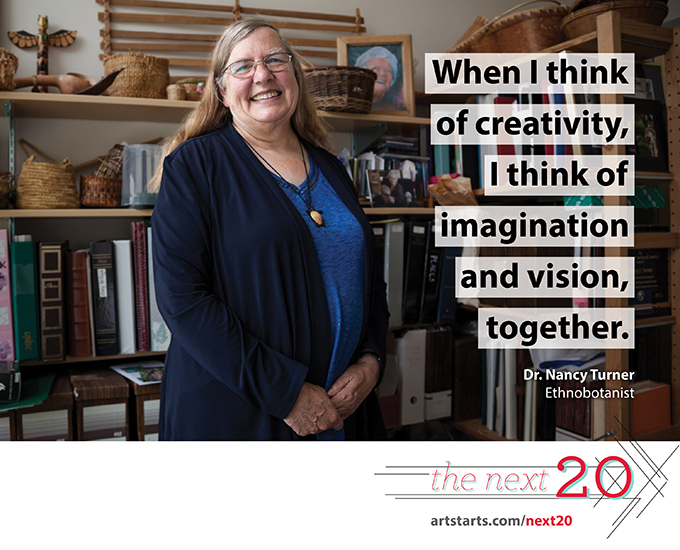July 12, 2016
The Next 20: Dr. Nancy Turner

This year is ArtStarts' 20th Anniversary. As we celebrate our accomplishments and impact, we are also inspired to think ahead about what the next 20 years hold for young people. What role can art and creativity play to support our next generation to thrive in the future?
To help us explore this question, we sat down with 20 community leaders across different sectors and asked them to share their story and thoughts on the relevance of art and creativity. Over 20 weeks, we'll share these stories with you. We hope that they will inspire you to join our community of supporters so that together we can continue to build a bright future for BC's young people.
This week's Next 20 community builder is Dr. Nancy Turner. Trudeau Fellow and Emeritus Professor at the University of Victoria, Dr. Nancy Turner is an ethnobotanist whose research integrates the fields of botany and ecology with anthropology, geography and linguistics, among others. She is interested in the traditional knowledge systems and traditional land and resource management systems of Indigenous Peoples, particularly in western Canada. Dr. Turner has authored, co-authored or co-edited over 20 books including Food Plants of Coastal First Peoples, Plant Technology of First Peoples in British Columbia, and Plants of Haida Gwaii.
What are some memorable experiences that you had as a child that shaped who you are today?
When I was three or four years old, we lived in Missoula, Montana. My sister and I would spend hours wandering around looking at flowers and playing. That's how I got to love plants so much. I knew all the names of the plants. My father and my grandfather were biologists and I was encouraged to foster that love of plants, animals, birds and I grew up pretty much as a naturalist. I was called Nancy Nature in school. Everybody knew how much I loved plants!
How would you describe your experiences at school?
I was known by my teachers and friends as someone who loved nature. Everyone was always supportive of that and interested in what I was doing. They encouraged me to carry on. I was the president of the Biology club in high school and had a very supportive environment to follow my passion.
How would you define creativity, and what role does it have in your practice and in your personal life?
When I think of creativity, I think of imagination and vision, together. Looking at something in a different way than what you've been trained to do, or what other people have done before, and being able to come to a different idea, a different space, a different interpretation of something.
To see beauty in things that we might overlook in our everyday busy lives and to be able to remark at small things, the flavour of a berry, or just how berries look in our hands, they look like jewels. It's not necessarily my creativity but the recognition of how creative nature is, and how amazing and beautiful it all is. That is, to me, what creativity is.
I would also add observation. I mentioned vision, which is in imagination, but also looking and noticing is so important. Often things of great value and beauty and importance are right in front of your eyes and you never notice them. Working with other people who are familiar with different ways of looking at things, who know stories, who know that music is important in learning - that, to me, is an important part of creativity.
Author Robin W. Kimmerer who wrote Braiding Sweetgrass says that kids can recognize 100 corporate logos but fewer than 10 plants. That's kind of a shocking reality. She also says that kids are not paying attention to what is around them in the natural world, because the natural world is not part of their daily life. How do you think we can encourage young people and future generations to pay attention to the natural world that lives around them?
We need to get children out in the woods. We need to get them out picking berries, talking to the trees, and learning their names. Like Robin W. Kimmerer would say, like our relatives, they are our relatives. We are all part of this big amazing relationship. Kids need to appreciate that.
It can be done easily because kids are like sponges. Take them out and have them pick berries, make baskets, take pictures of plants or just look at bees pollinating flowers. They love that kind of thing. Any kid that you manage to get out into nature really enjoys it, and they'll learn those things. They'll learn their names and they'll learn to recognize them and to value them.
Robin W. Kimmerer also says that attention to the natural world and curiosity can be a doorway to gratitude and reciprocity. How do you think we can teach this idea of empathy and gratitude to the natural world, to kids?
 Start with something that's relatively easy to understand like a bird with its nest and how it goes and gets food and brings it back for its babies. Kids will think about that, as a little child, and their needs. They will think of how their parents look after them and find food for them. Kids can relate to those baby birds. It's a matter of just creating the time and space for that to happen and having teachers around who can facilitate that kind of learning and open the door.
Start with something that's relatively easy to understand like a bird with its nest and how it goes and gets food and brings it back for its babies. Kids will think about that, as a little child, and their needs. They will think of how their parents look after them and find food for them. Kids can relate to those baby birds. It's a matter of just creating the time and space for that to happen and having teachers around who can facilitate that kind of learning and open the door.
What type of questions can young generations start asking to reestablish a better relationship with the natural world?
It is better to ask general questions. If you are talking to other people and you want to know something, it is much better to ask a general broad question and then sit back and listen. When I learned (the most was what I asked) was to ask something quite general like "tell me about this plant" or "what is this?" or "can you tell me about this?" As my elders would say, they were taught growing up “use this (eyes), and this (ears), before you use this (mouth)”. So don’t ask too many questions and don’t try to talk very much but listen if you want to really learn from people.
That is when you are going to get the richest response. You might even get surprises that you never even thought to ask. If you are too careful and too narrow in your questions you are going to miss important things that people have to share with you.
Can you tell us about your work with Aboriginal communities and the role of children in those communities?
I have an ongoing research project idea called Children Foraging. Over the years of working with elders, I hear many stories about their childhood and how they spent it outdoors with their parents, grandparents, other kids and how much fun it was and what joy they had.
They were also extremely self-sufficient and often, they were food providers. They would be the ones to pick the berries, or get the Thimbleberry sprouts and bring them back by to the village. Kids growing up in these communities also had a lot of responsibility and a lot of knowledge. I guess this is indicative of what is possible for children to learn. They are capable, they are like little sponges and they can learn so much at that age. From the time they are three or four, they are just so eager to learn and to be part of something. It is such an amazing learning time. I think learning by doing is so important, like learning by feeling, participating, doing things, singing, hearing stories and dancing.
Our whole bodies are repositories of what we learn. It's not just in our brain, it's in all of us that embodies this knowledge and practice - and the feelings and emotions that go with it. That's why doing art, music, dance and all the things that go with your heart and your feelings more than with your reason and rationality, are really important parts of learning.
How do you imagine the world 20 years from now?
I would like to think there will be a leveling out and a balance when we realize that once we satisfy our immediate needs for food and shelter, there is very little in the way of material things that we need to have to make us happy. You can find happiness by going out and watching a bird or a butterfly. Those things give you just as much happiness as playing a video game or going somewhere and basking on the beach. If we are more careful in the way we use the resources that we have and not grasping for more and more stuff, I think it would be a better world and I think that is what is going to happen.
We want to hear from you!
What do you imagine the world will be like in 20 years?
Share your ideas on Facebook.
At ArtStarts in Schools, we want to ensure that young people across British Columbia have opportunities to develop their curiosity and creative potential and to build skills to thrive in the next 20 years—and beyond.
You can help us realize our vision by donating today and joining our community of supporters.
Learn more about ArtStarts in Schools and the work we do and discover additional ways you can show your support.
Keep up with the Next 20 interviews on Facebook, Twitter or Instagram. Sign up for our newsletter to get all the latest ArtStarts news.
Past Stories
Search by category
Accessibility | AIC Projects | Arts Integration in Action | ArtStarts Artists | ArtStarts Team | Community Events and Engagement | Exhibitions | Grants | Guest Blog | Infusion Pro-D | Knowledge Philanthropist | Meet a Community Art Star | Showcase | Supporters | The Next 20


